Evaluating the Stacked Economic Value of Load Shifting and Microgrid Control
Abstract
1. Introduction
- Develop a generalized control strategy that jointly optimizes microgrid operation and load shifting techniques to create “stacked economic value.”
- Demonstrate how load shifting improves the technical and financial value of existing microgrid investments for a client with critical loads.
- Evaluate how the amount of load shifting and duration of load shifting affect the limits to which optimization algorithms can minimize microgrid operating costs.
2. Materials and Methods
2.1. Optimization Platform
2.2. Scenarios and Optimizations
- No microgrid and no load shifting (base case)—No microgrid assets are installed, and no load shifting is available. Loads are served only by utility purchases. There are no features available to the customer to control or reduce the load.
- Load shifting with no microgrid—No microgrid assets are installed. Loads are served only by utility purchases. A site controller employs load shifting, which can reschedule the load to meet its demand at a time different from the originally scheduled time.
- Microgrid with no load shifting—Microgrid assets are installed, such as solar PV and battery energy storage. Load can be met through on-site generation and storage or through utility purchases. There is no ability for the customer to control the timing of load consumption.
- Microgrid and load shifting—Microgrid assets are installed, and the load can be met through on-site generation, storage, or utility purchases. Purchases from the utility grid or microgrid assets such as PV or battery energy storage could supply the energy as scheduled, or load shifting could reschedule the load to meet its demand at a time different than originally scheduled. Furthermore, if load shifting reschedules the load, the purchases from the utility grid or energy generated by microgrid assets could supply this energy.
- Maximum duration of load shifting: 1, 2, or 3 h.
- Maximum percentage of daily load that can be load shifted: 5%, 10%, 15%, 20%, or 25%.
2.3. Loads
2.4. Microgrid Assets
2.5. Utility Rate Structure
3. Results and Analysis
3.1. Annual Results
3.2. Monthly Results
3.3. Daily Results
4. Discussion
Author Contributions
Funding
Data Availability Statement
Acknowledgments
Conflicts of Interest
Abbreviations
| DER | distributed energy resource |
| kW | kilowatt |
| MILP | mixed-integer linear programming |
| PV | photovoltaic |
References
- Lu, X.; Wang, J.; Guo, L. Using microgrids to enhance energy security and resilience. Electr. J. 2016, 29, 8–15. [Google Scholar] [CrossRef]
- Carvalho, D.B.; Bortoni, E.D.C. Proposed model with weighted parameters for microgrid management: Incorporating diverse load profiles, assorted tariff policies, and energy storage devices. Energy 2024, 296, 130976. [Google Scholar] [CrossRef]
- Rengasamy, M.; Gangatharan, S.; Elavarasan, R.M.; Mihet-Popa, L. The motivation for incorporation of microgrid technology in rooftop solar photovoltaic deployment to enhance energy economics. Sustainability 2020, 12, 10365. [Google Scholar] [CrossRef]
- Mandal, S.; Mandal, K.K. Optimal energy management of microgrids under environmental constraints using chaos enhanced differential evolution. Renew. Energy Focus 2020, 34, 129–141. [Google Scholar] [CrossRef]
- Markov, K.; Rajaković, N. Multi-energy microgrids with ecotourism purposes: The impact of the power market and the connection line. Energy Convers. Manag. 2019, 196, 1105–1112. [Google Scholar] [CrossRef]
- Jackson, R.; Zulkifli, S.A.; Benbouzid, M.; Salimin, S.; Khan, M.H.; Elhassan, G.; Pathan, E. A comprehensive motivation of multilayer control levels for microgrids: Synchronization, voltage and frequency restoration perspective. Appl. Sci. 2020, 10, 8355. [Google Scholar] [CrossRef]
- Hosseinnia, H.; Nazarpour, D.; Talavat, V. Utilising reliability-constrained optimisation approach to model microgrid operator and private investor participation in a planning horizon. IET Gener. Transm. Distrib. 2018, 12, 5798–5810. [Google Scholar] [CrossRef]
- Gheouany, S.; Ouadi, H.; Giri, F.; El Bakali, S. Experimental validation of multi-stage optimal energy management for a smart microgrid system under forecasting uncertainties. Energy Convers. Manag. 2023, 291, 117309. [Google Scholar] [CrossRef]
- Liu, Z.; Chen, Y.; Zhuo, R.; Jia, H. Energy storage capacity optimization for autonomy microgrid considering CHP and EV scheduling. Appl. Energy 2018, 210, 1113–1125. [Google Scholar] [CrossRef]
- Keskin, I.; Soykan, G. Reduction of peak power consumption by using photovoltaic panels in Turkey. In Proceedings of the 2017 IEEE 6th International Conference on Renewable Energy Research and Applications (ICRERA), San Diego, CA, USA, 5–8 November 2017. [Google Scholar] [CrossRef]
- Ma, Y.-W.; Ding, S.-Q.; Jing, Q.-M.; Tang, X.-L. Economic dispatch of household PV-BS-EV microgrid under TOU tariffs. J. Phys. Conf. Ser. 2021, 1754, 012015. [Google Scholar] [CrossRef]
- Ross, M.; Abbey, C.; Bouffard, F.; Joos, G. Microgrid Economic Dispatch with Energy Storage Systems. IEEE Trans. Smart Grid 2018, 9, 3039–3047. [Google Scholar] [CrossRef]
- Tripathy, S.K. Stacked-Value of Battery Storage: Effect of Battery Storage Penetration on Power Dispatch. Master’s Thesis, Arizona State University, Tempe, AZ, USA, 2020. [Google Scholar]
- Karimi, H.; Gharehpetian, G.B.; Ahmadiahangar, R.; Rosin, A. Optimal energy management of grid-connected multi-microgrid systems considering demand-side flexibility: A two-stage multi-objective approach. Electr. Power Syst. Res. 2023, 214, 108902. [Google Scholar] [CrossRef]
- Zheng, S.; Jin, X.; Huang, G.; Lai, A.C. Coordination of commercial prosumers with distributed demand-side flexibility in energy sharing and management system. Energy 2022, 248, 123634. [Google Scholar] [CrossRef]
- Jung, S.; Yoon, Y.; Im, P.; Salonvaara, M.; Dong, J.; Cui, B.; Lapsa, M. Peak cooling load shift capability of a thermal energy storage system integrated with an active insulation system in US climate zones. Energy Build. 2022, 277, 112484. [Google Scholar] [CrossRef]
- Whitcraft, D.S.; Sullivan, K.; Okamura, P.; Slife, C. Implementing Load Shifting Using Thermal Energy Ice Storage; Arizona State University: Tempe, AZ, USA, 2016. [Google Scholar]
- Tang, C.; Li, N.; Bao, L. Predictive Control Modeling of Regional Cooling Systems Incorporating Ice Storage Technology. Buildings 2024, 14, 2488. [Google Scholar] [CrossRef]
- Zhang, K.; Yu, J.; Ren, Y. Demand side management of energy consumption in a photovoltaic integrated greenhouse. Int. J. Electr. Power Energy Syst. 2022, 134, 107433. [Google Scholar] [CrossRef]
- Alzola, J.A.; Vechiu, I.; Camblong, H.; Santos, M.; Sall, M.; Sow, G. Microgrids project, Part 2: Design of an electrification kit with high content of renewable energy sources in Senegal. Renew. Energy 2009, 34, 2151–2159. [Google Scholar] [CrossRef]
- Ribeiro, F.; Ferreira, P.; Araújo, M. Evaluating future scenarios for the power generation sector using a Multi-Criteria Decision Analysis (MCDA) tool: The Portuguese case. Energy 2013, 52, 126–136. [Google Scholar] [CrossRef]
- Puradbhat, S.; Doolla, S.; Bhavaraju, V. A Framework for Considering Capital Cost Limit in Sizing Microgrid Distributed Energy Resources—Application to Industrial Microgrids. IEEE Trans. Ind. Appl. 2021, 57, 6688–6699. [Google Scholar] [CrossRef]
- Quynh, N.V.; Ali, Z.M.; Alhaider, M.M.; Rezvani, A.; Suzuki, K. Optimal energy management strategy for a renewable-based microgrid considering sizing of battery energy storage with control policies. Int. J. Energy Res. 2021, 45, 5766–5780. [Google Scholar] [CrossRef]
- Li, B.; Roche, R.; Miraoui, A. Microgrid sizing with combined evolutionary algorithm and MILP unit commitment. Appl. Energy 2017, 188, 547–562. [Google Scholar] [CrossRef]
- Ghaffari, M.; Afsharchi, M. Learning to shift load under uncertain production in the smart grid. Int. Trans. Electr. Energy Syst. 2021, 31, e12748. [Google Scholar] [CrossRef]
- Yu, N.; Kang, J.S.; Chang, C.C.; Lee, T.Y.; Lee, D.Y. Robust economic optimization and environmental policy analysis for microgrid planning: An application to Taichung Industrial Park, Taiwan. Energy 2016, 113, 671–682. [Google Scholar] [CrossRef]
- Jin, M.; Feng, W.; Liu, P.; Marnay, C.; Spanos, C. MOD-DR: Microgrid optimal dispatch with demand response. Appl. Energy 2017, 187, 758–776. [Google Scholar] [CrossRef]
- Wynn, S.L.L.; Boonraksa, T.; Boonraksa, P.; Pinthurat, W.; Marungsri, B. Decentralized Energy Management System in Microgrid Considering Uncertainty and Demand Response. Electronics 2023, 12, 237. [Google Scholar] [CrossRef]
- Dey, B.; Basak, S.; Pal, A. Demand-side management based optimal scheduling of distributed generators for clean and economic operation of a microgrid system. Int. J. Energy Res. 2022, 46, 8817–8837. [Google Scholar] [CrossRef]
- Bagheri, F.; Dagdougui, H.; Gendreau, M. Stochastic optimization and scenario generation for peak load shaving in Smart District microgrid: Sizing and operation. Energy Build. 2022, 275, 112426. [Google Scholar] [CrossRef]
- Morsali, R.; Kowalczyk, R. Demand response based day-ahead scheduling and battery sizing in microgrid management in rural areas. IET Renew. Power Gener. 2018, 12, 1651–1658. [Google Scholar] [CrossRef]
- Mahmoud, T.S.; Ahmed, B.S.; Hassan, M.Y. The role of intelligent generation control algorithms in optimizing battery energy storage systems size in microgrids: A case study from Western Australia. Energy Convers. Manag. 2019, 196, 1335–1352. [Google Scholar] [CrossRef]
- Urbanucci, L. Limits and potentials of Mixed Integer Linear Programming methods for optimization of polygeneration energy systems. In Energy Procedia; Elsevier Ltd.: Amsterdam, The Netherlands, 2018; pp. 1199–1205. [Google Scholar] [CrossRef]
- Strbac, G. Demand side management: Benefits and challenges. Energy Policy 2008, 36, 4419–4426. [Google Scholar] [CrossRef]
- Alasseri, R.; Tripathi, A.; Rao, T.J.; Sreekanth, K.J. A review on implementation strategies for demand side management (DSM) in Kuwait through incentive-based demand response programs. Renew. Sustain. Energy Rev. 2017, 77, 617–635. [Google Scholar] [CrossRef]
- Huang, W.; Zhang, N.; Kang, C.; Li, M.; Huo, M. From demand response to integrated demand response: Review and prospect of research and application. Prot. Control. Mod. Power Syst. 2019, 4, 1–13. [Google Scholar] [CrossRef]
- Sithole, S.M.; Gous, A.G.S.; Schutte, C.S.L. A dynamic simulation model for optimal deep-level mine cooling management and operational decision-making for Eskom’s load curtailment. S. Afr. J. Ind. Eng. 2023, 34, 68–83. [Google Scholar] [CrossRef]
- Katz, J.; Andersen, F.M.; Morthorst, P.E. Load-shift incentives for household demand response: Evaluation of hourly dynamic pricing and rebate schemes in a wind-based electricity system. Energy 2016, 115, 1602–1616. [Google Scholar] [CrossRef]
- Jasim, A.M.; Jasim, B.H.; Mohseni, S.; Brent, A.C. Energy Internet-Based Load Shifting in Smart Microgrids: An Experimental Study. Energies 2023, 16, 4957. [Google Scholar] [CrossRef]
- Philipo, G.H.; Kakande, J.N.; Krauter, S. Neural Network-Based Demand-Side Management in a Stand-Alone Solar PV-Battery Microgrid Using Load-Shifting and Peak-Clipping. Energies 2022, 15, 5215. [Google Scholar] [CrossRef]
- Teamah, H.M.; Lightstone, M.F. Numerical study of the electrical load shift capability of a ground source heat pump system with phase change thermal storage. Energy Build. 2019, 199, 235–246. [Google Scholar] [CrossRef]
- Arababadi, R.; Parrish, K.; Reddy, A.; Jackson, R. Operational and Technological Peak Load Shifting Strategies for Residential Buildings; Arizona State University: Tempe, AZ, USA, 2016. [Google Scholar]
- Belaid, F.; Youssef, A.B.; Omrani, N. Investigating the factors shaping residential energy consumption patterns in France: Evidence form quantile regression. Eur. J. Comp. Econ. 2020, 17, 127–151. [Google Scholar] [CrossRef]
- Wang, R.; Li, P.; Han, Z.; Zhou, Z.; Cao, J.; Wang, X. Bi-Level Design Optimization for Demand-Side Interval Temperature Control in District Heating Systems. Buildings 2025, 15, 365. [Google Scholar] [CrossRef]
- Zhang, Y.; Ling, Z.; Liu, M.; Gang, W.; Su, L. An Energy Portrait-Based Identification Method of Building Users for Demand Response. Buildings 2024, 14, 2534. [Google Scholar] [CrossRef]
- Nogueira, T.; Sousa, E.; Alves, G.R. Electric vehicles growth until 2030: Impact on the distribution network power. Energy Rep. 2022, 8, 145–152. [Google Scholar] [CrossRef]
- Gnann, T.; Klingler, A.L.; Kühnbach, M. The load shift potential of plug-in electric vehicles with different amounts of charging infrastructure. J. Power Sources 2018, 390, 20–29. [Google Scholar] [CrossRef]
- Babrowski, S.; Heinrichs, H.; Jochem, P.; Fichtner, W. Load shift potential of electric vehicles in Europe. J. Power Sources 2014, 255, 283–293. [Google Scholar] [CrossRef]
- Wang, W.; Wang, D.; Zhao, Y.; Yu, Y.; Wang, Y. Research on capacity optimization and real-time control of island microgrid considering time-shifting load. Energy Rep. 2022, 8, 990–997. [Google Scholar] [CrossRef]
- Hanzala, M.; Memon, Z.; Hussain, M.I.; Azeem, F.; Shahzad, N.; J.-Kim, T. Fuzzy-Logic-Based Cascaded Decentralized Control and Power Quantification of Residential Buildings for Effective Energy Load Management. Buildings 2024, 14, 2896. [Google Scholar] [CrossRef]
- Yang, Y.; DeFrain, J.; Faruqui, A. Conceptual discussion on a potential hidden cross-seasonal storage: Cross-seasonal load shift in industrial sectors. Electr. J. 2020, 33, 106846. [Google Scholar] [CrossRef]
- Lebedeva, K.; Borodinecs, A.; Krumins, A.; Tamane, A.; Dzelzitis, E. Potential of End-User Electricity Peak Load Shift in Latvia. Latv. J. Phys. Tech. Sci. 2021, 58, 32–44. [Google Scholar] [CrossRef]
- Rivers, N.; Shaffer, B. Stretching the duck: How rising temperatures will change the level and shape of future electricity consumption. Energy J. 2020, 41, 55–88. [Google Scholar] [CrossRef]
- Middelberg, A.; Zhang, J.; Xia, X. An optimal control model for load shifting—With application in the energy management of a colliery. Appl. Energy 2009, 86, 1266–1273. [Google Scholar] [CrossRef]
- Hu, M.; Xiao, F.; Jørgensen, J.B.; Li, R. Price-responsive model predictive control of floor heating systems for demand response using building thermal mass. Appl. Therm. Eng. 2019, 153, 316–329. [Google Scholar] [CrossRef]
- Talami, R.; Dawoodjee, I.; Ghahramani, A. Quantifying Energy Savings from Optimal Selection of HVAC Temperature Setpoints and Setbacks across Diverse Occupancy Rates and Patterns. Buildings 2023, 13, 2998. [Google Scholar] [CrossRef]
- Nelson, J.; Johnson, N.G.; Fahy, K.; Hansen, T.A. Statistical development of microgrid resilience during islanding operations. Appl. Energy 2020, 279, 115724. [Google Scholar] [CrossRef]
- Nelson, J.; Johnson, N.G.; Chinimilli, P.T.; Zhang, W. Residential cooling using separated and coupled precooling and thermal energy storage strategies. Appl. Energy 2019, 252, 113414. [Google Scholar] [CrossRef]
- Pothireddy, K.M.R.; Vuddanti, S.; Salkuti, S.R. Impact of demand response on optimal sizing of distributed generation and customer tariff. Energies 2022, 15, 190. [Google Scholar] [CrossRef]
- Grant, C.; Rizzo, C.; Hardin, K.; Amon, C. Households Transforming the Grid: Distributed Energy Resources Are Key to Affordable Clean Power. 2024. Available online: https://www.deloitte.com/us/en/insights/industry/power-and-utilities/der-grid-modernization.html (accessed on 15 May 2025).
- XENDEE. Objective Function. Available online: https://asu.xendee.com/Home/Documentation/objectivefunction (accessed on 26 April 2025).
- Clauß, J.; Brozovsky, J.; Georges, L. Demonstrating the load-shifting potential of a schedule-based control in a real-life educational building. Energy Build. 2024, 316, 114321. [Google Scholar] [CrossRef]
- Agarwal, Y.; Balaji, B.; Dutta, S.; Gupta, R.K.; Weng, T. Duty-Cycling Buildings Aggressively: The Next Frontier in HVAC Control. In Proceedings of the 10th ACM/IEEE International Conference on Information Processing in Sensor Networks, Chicago, IL, USA, 12–14 April 2011. [Google Scholar]
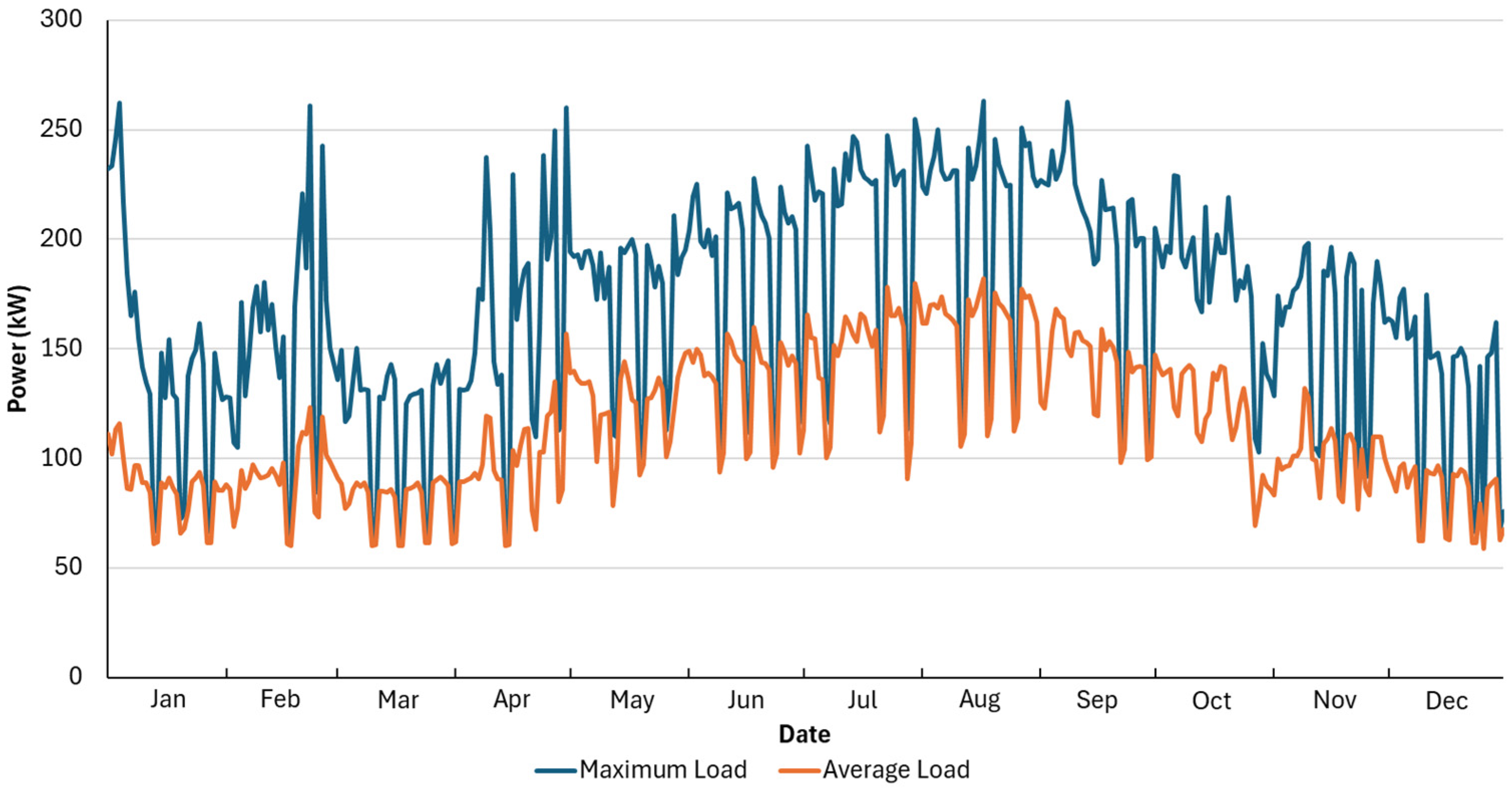
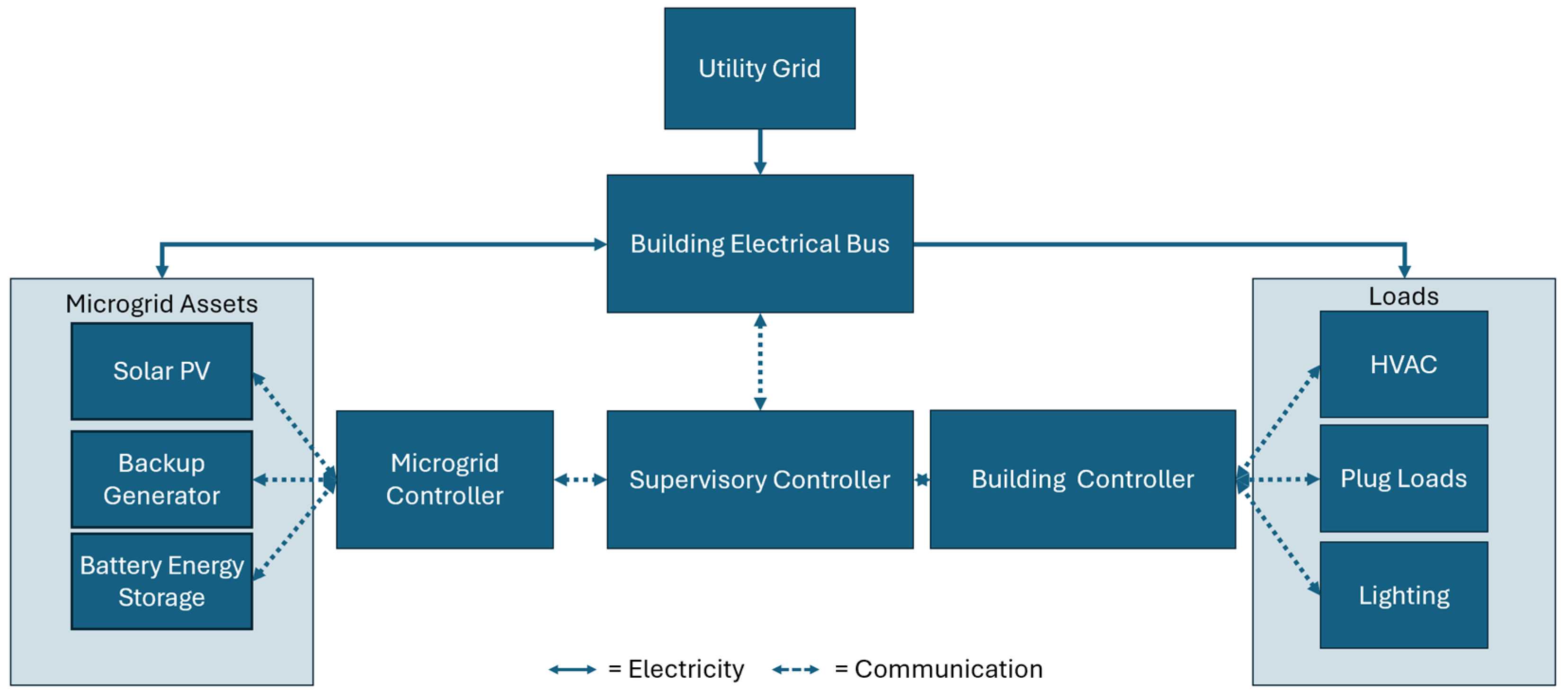

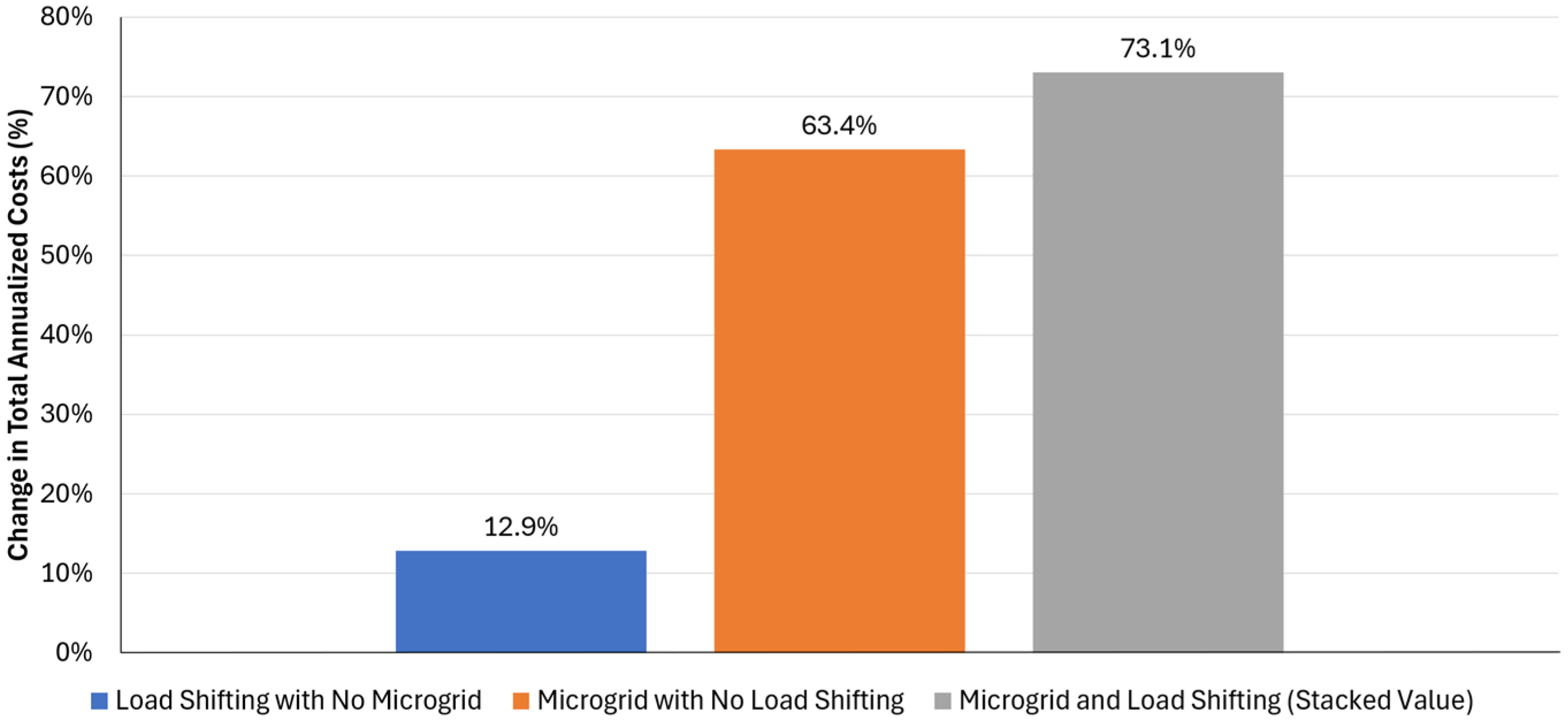
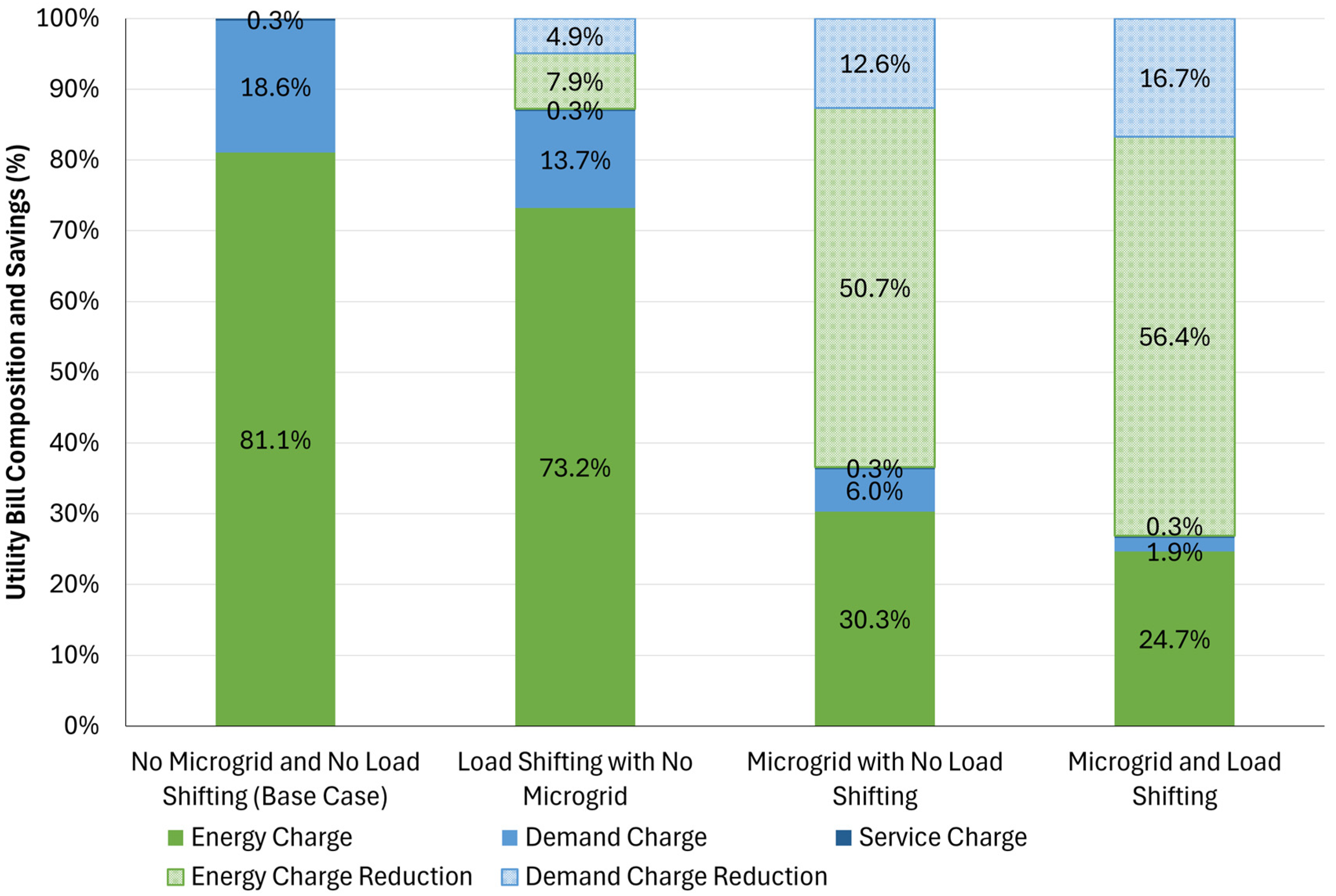
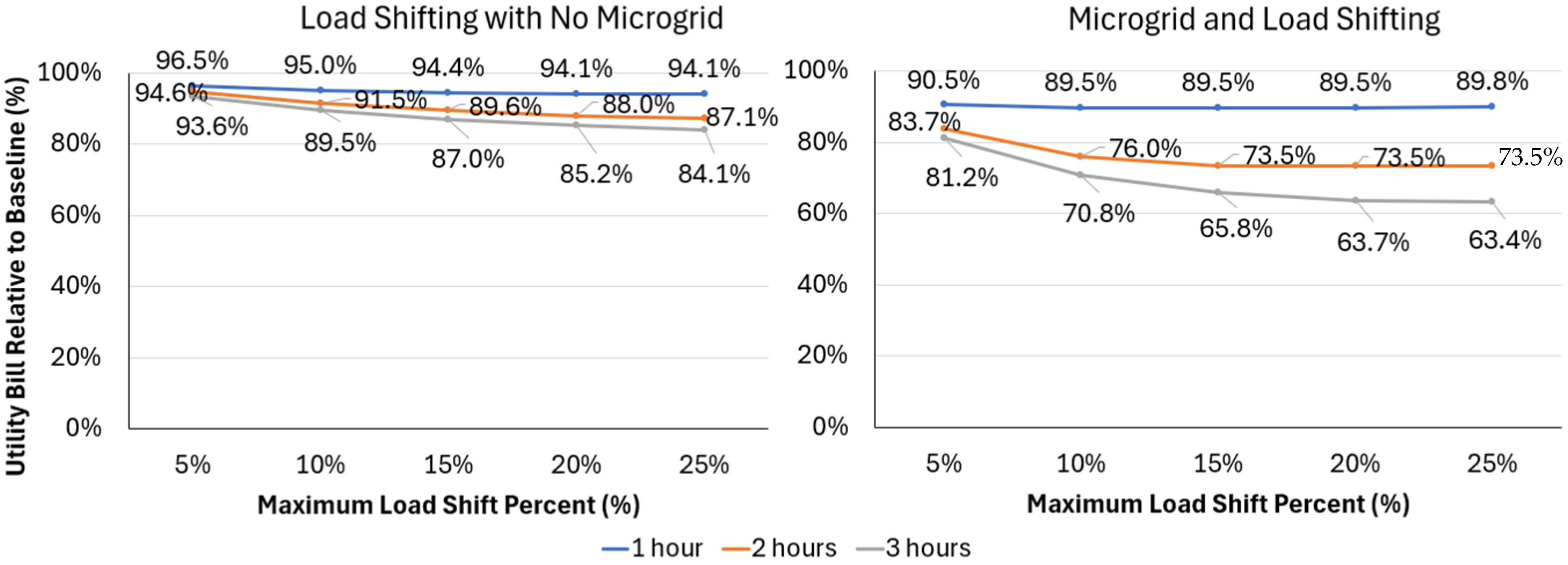
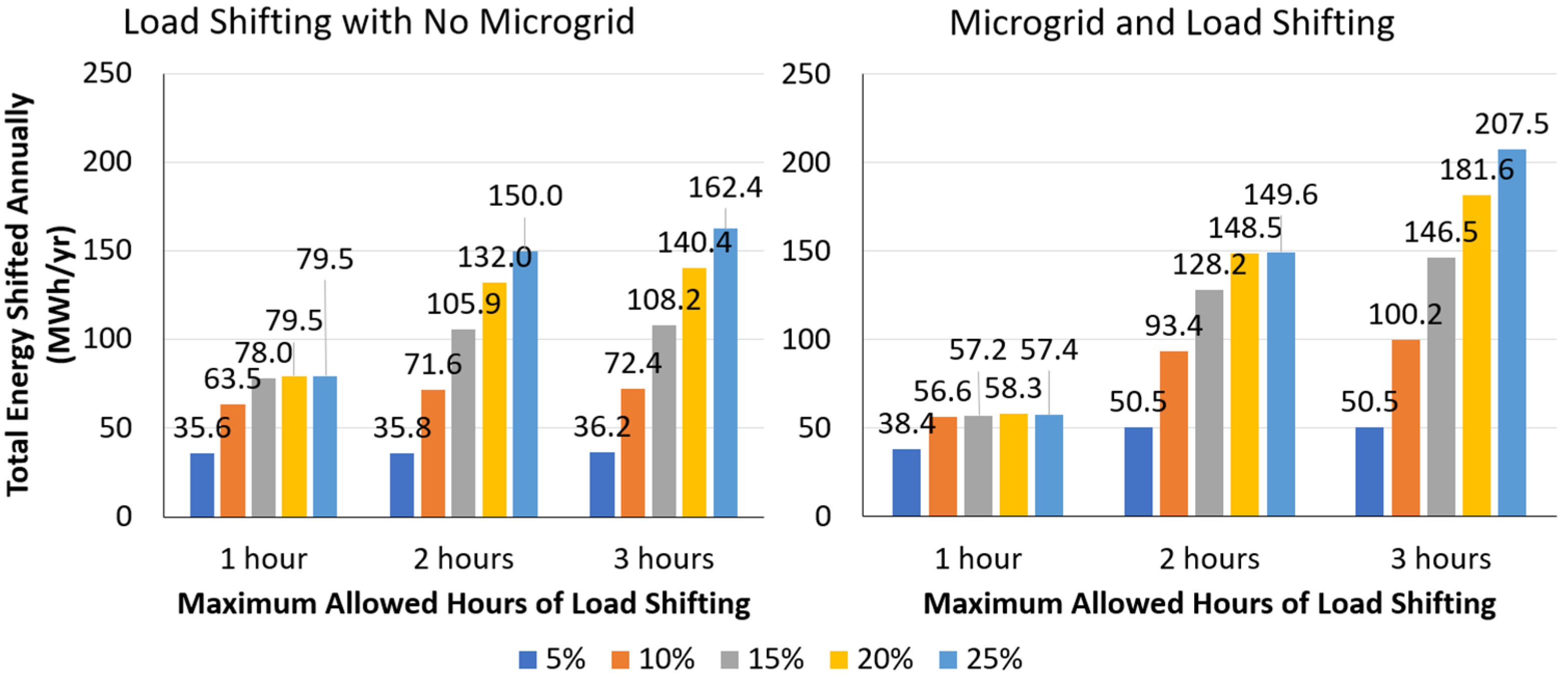
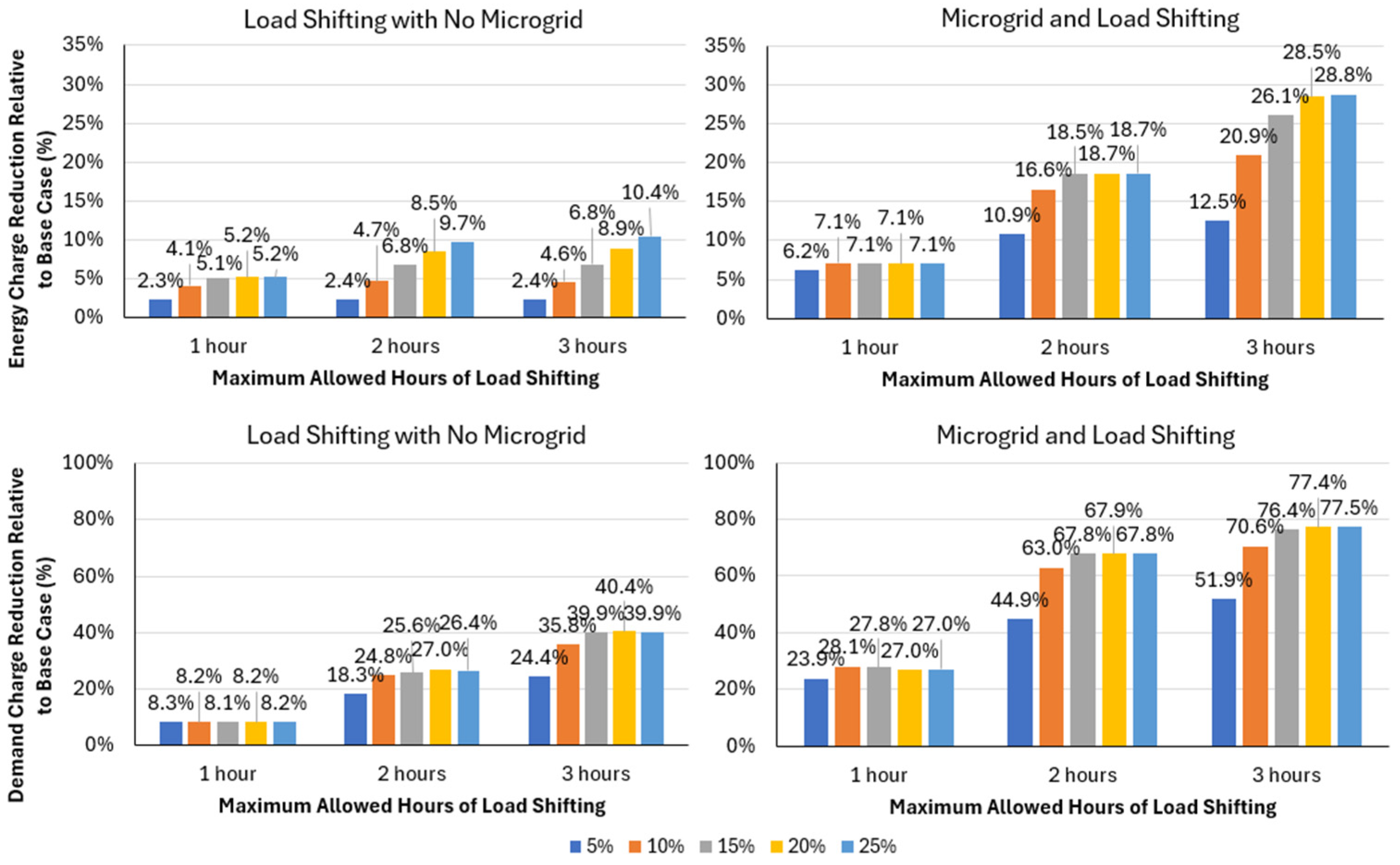
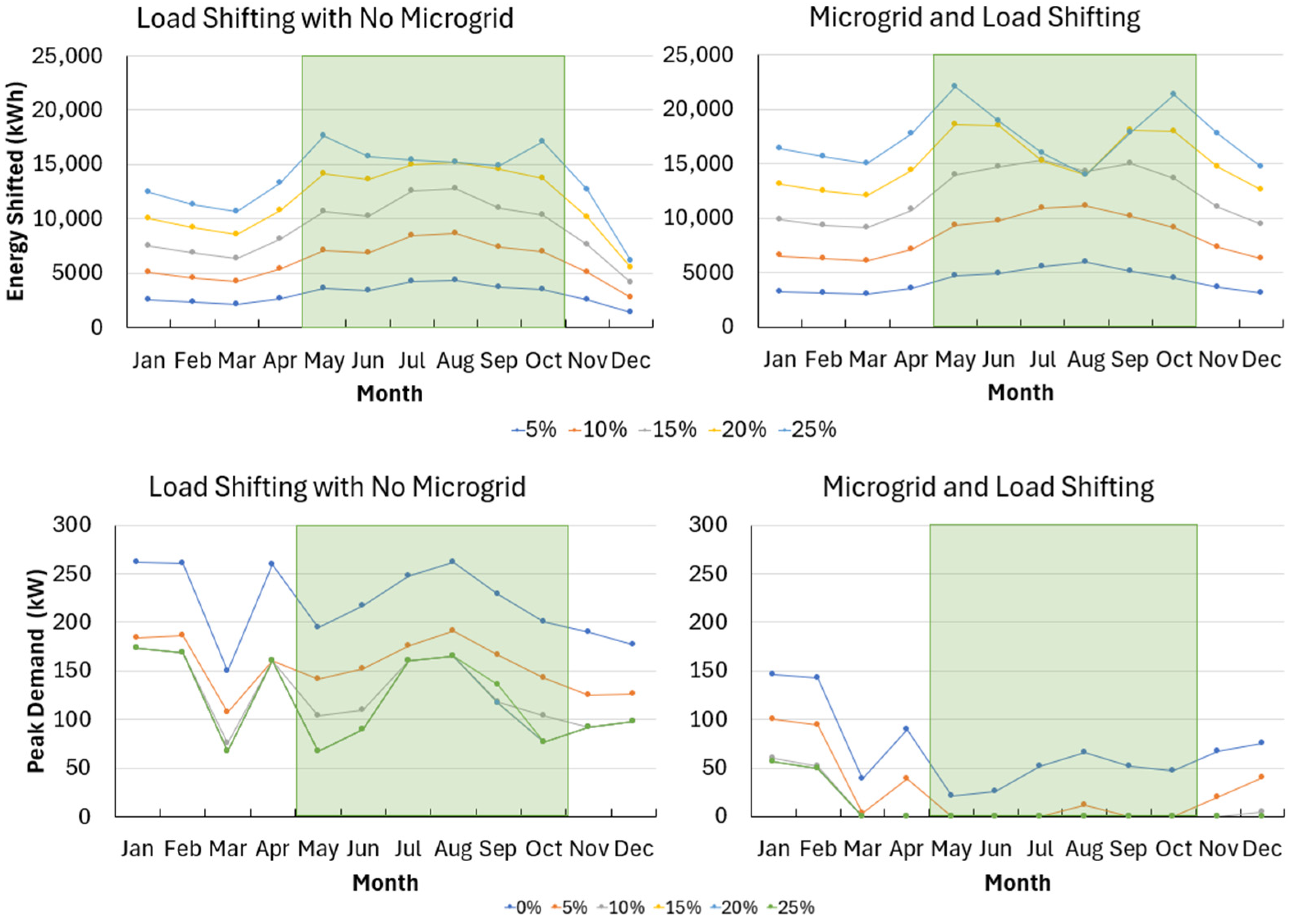
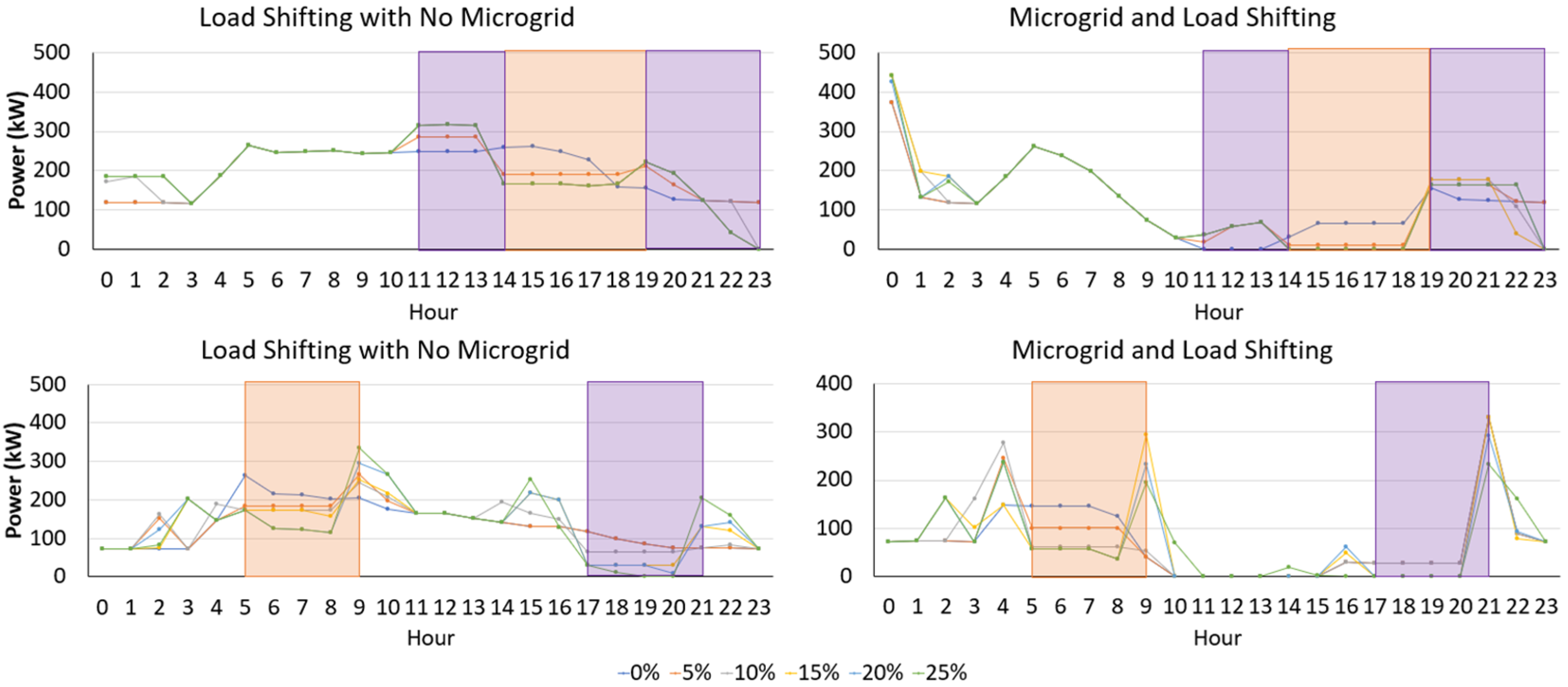
| Asset | Variable | Value | Unit |
|---|---|---|---|
| Solar PV | Array Rated Capacity | 331 | kW DC |
| Solar PV | Panel Efficiency | 19 | % |
| Dual-port Inverter | Inverter Output Capacity | 250 | kW AC |
| Dual-port Inverter | Inverter Efficiency | 96 | % |
| Battery Storage | Rated Capacity | 275 | kWh |
| Battery Storage | Charging Efficiency | 97 | % |
| Battery Storage | Discharging Efficiency | 97 | % |
| Battery Storage | Minimum State of Charge | 5 | % |
| Battery Storage | Maximum State of Charge | 100 | % |
| Charge Category | Months | ToU Period | Applicable Days and Times | Value | Units |
|---|---|---|---|---|---|
| Energy Price | November–April | Off-Peak | Weekdays: 12 a.m.–5 a.m., 9 a.m.–5 p.m., 9 p.m.–12 a.m. Weekends: All Day | 0.0488 | $/kWh |
| Energy Price | November–April | Mid-Peak | Weekdays: 5 p.m.–9 p.m. | 0.0945 | $/kWh |
| Energy Price | November–April | On-Peak | Weekdays: 5 a.m.–9 a.m. | 0.1010 | $/kWh |
| Energy Price | May–October | Off-Peak | Weekdays: 12 a.m.–11 a.m. Weekends: All Day | 0.0529 | $/kWh |
| Energy Price | May–October | Mid-Peak | Weekdays: 11 a.m.–2 p.m., 7 p.m.–12 a.m. | 0.0965 | $/kWh |
| Energy Price | May–October | On-Peak | Weekdays: 2 p.m.–7 p.m. | 0.1357 | $/kWh |
| Demand Charge | November–April | Off-Peak | Weekdays: 12 a.m.–5 a.m., 9 a.m.–5 p.m., 9 p.m.–12 a.m. Weekends: All Day | 0 | $/kW |
| Demand Charge | November–April | Mid-Peak | Weekdays: 5 p.m.–9 p.m. | 1.05 | $/kW |
| Demand Charge | November–April | On-Peak | Weekdays: 5 a.m.–9 a.m. | 4.69 | $/kW |
| Demand Charge | May–October | Off-Peak | Weekdays: 12 a.m.–11 a.m. Weekends: All Day | 0 | $/kW |
| Demand Charge | May–October | Mid-Peak | Weekdays: 11 a.m.–2 p.m., 7 p.m.–12 a.m. | 1.05 | $/kW |
| Demand Charge | May–October | On-Peak | Weekdays: 2 p.m.–7 p.m. | 4.69 | $/kW |
| Service Charge | January–December | 22.72 | $/month |
Disclaimer/Publisher’s Note: The statements, opinions and data contained in all publications are solely those of the individual author(s) and contributor(s) and not of MDPI and/or the editor(s). MDPI and/or the editor(s) disclaim responsibility for any injury to people or property resulting from any ideas, methods, instructions or products referred to in the content. |
© 2025 by the authors. Licensee MDPI, Basel, Switzerland. This article is an open access article distributed under the terms and conditions of the Creative Commons Attribution (CC BY) license (https://creativecommons.org/licenses/by/4.0/).
Share and Cite
Garcesa, A.; Johnson, N.G.; Nelson, J. Evaluating the Stacked Economic Value of Load Shifting and Microgrid Control. Buildings 2025, 15, 2378. https://doi.org/10.3390/buildings15132378
Garcesa A, Johnson NG, Nelson J. Evaluating the Stacked Economic Value of Load Shifting and Microgrid Control. Buildings. 2025; 15(13):2378. https://doi.org/10.3390/buildings15132378
Chicago/Turabian StyleGarcesa, Arnel, Nathan G. Johnson, and James Nelson. 2025. "Evaluating the Stacked Economic Value of Load Shifting and Microgrid Control" Buildings 15, no. 13: 2378. https://doi.org/10.3390/buildings15132378
APA StyleGarcesa, A., Johnson, N. G., & Nelson, J. (2025). Evaluating the Stacked Economic Value of Load Shifting and Microgrid Control. Buildings, 15(13), 2378. https://doi.org/10.3390/buildings15132378







